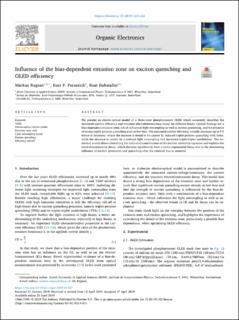Please use this identifier to cite or link to this item:
https://doi.org/10.21256/zhaw-18982| Publication type: | Article in scientific journal |
| Type of review: | Peer review (publication) |
| Title: | Influence of the bias-dependent emission zone on exciton quenching and OLED efficiency |
| Authors: | Regnat, Markus Pernstich, Kurt Ruhstaller, Beat |
| et. al: | No |
| DOI: | 10.1016/j.orgel.2019.04.027 10.21256/zhaw-18982 |
| Published in: | Organic Electronics |
| Volume(Issue): | 70 |
| Page(s): | 219 |
| Pages to: | 226 |
| Issue Date: | Jul-2019 |
| Publisher / Ed. Institution: | Elsevier |
| ISSN: | 1566-1199 |
| Language: | English |
| Subject (DDC): | 621.3: Electrical, communications, control engineering 621.3: Electrical, communications, control engineering |
| Abstract: | We present an electro-optical model of a three-layer phosphorescent OLED which accurately describes the measured current efficiency and transient electroluminescence decay for different biases. Central findings are a bias-dependent emission zone, which influences light outcoupling as well as exciton quenching, and the presence of strong triplet-polaron quenching even at low bias. The measured current efficiency initially increases up to 9 V before it decreases, where the increase is found to be caused by reduced triplet-polaron quenching with holes, while the decrease is caused by a reduced light outcoupling and increased triplet-triplet annihilation. The numerical model allows identifying the individual contributions of the exciton continuity equation and explains the electroluminescence decay, which deviates significantly from a mono-exponential decay due to the dominating influence of exciton generation and quenching after the external bias is removed. |
| URI: | https://digitalcollection.zhaw.ch/handle/11475/18982 |
| Fulltext version: | Published version |
| License (according to publishing contract): | CC BY-NC-ND 4.0: Attribution - Non commercial - No derivatives 4.0 International |
| Departement: | School of Engineering |
| Organisational Unit: | Institute of Computational Physics (ICP) |
| Appears in collections: | Publikationen School of Engineering |
Files in This Item:
| File | Description | Size | Format | |
|---|---|---|---|---|
| 2019Regnat-etal_Influence of the bias-dependant_Organic electronics.pdf | 2.14 MB | Adobe PDF |  View/Open |
Show full item record
Regnat, M., Pernstich, K., & Ruhstaller, B. (2019). Influence of the bias-dependent emission zone on exciton quenching and OLED efficiency. Organic Electronics, 70, 219–226. https://doi.org/10.1016/j.orgel.2019.04.027
Regnat, M., Pernstich, K. and Ruhstaller, B. (2019) ‘Influence of the bias-dependent emission zone on exciton quenching and OLED efficiency’, Organic Electronics, 70, pp. 219–226. Available at: https://doi.org/10.1016/j.orgel.2019.04.027.
M. Regnat, K. Pernstich, and B. Ruhstaller, “Influence of the bias-dependent emission zone on exciton quenching and OLED efficiency,” Organic Electronics, vol. 70, pp. 219–226, Jul. 2019, doi: 10.1016/j.orgel.2019.04.027.
REGNAT, Markus, Kurt PERNSTICH und Beat RUHSTALLER, 2019. Influence of the bias-dependent emission zone on exciton quenching and OLED efficiency. Organic Electronics. Juli 2019. Bd. 70, S. 219–226. DOI 10.1016/j.orgel.2019.04.027
Regnat, Markus, Kurt Pernstich, and Beat Ruhstaller. 2019. “Influence of the Bias-Dependent Emission Zone on Exciton Quenching and OLED Efficiency.” Organic Electronics 70 (July): 219–26. https://doi.org/10.1016/j.orgel.2019.04.027.
Regnat, Markus, et al. “Influence of the Bias-Dependent Emission Zone on Exciton Quenching and OLED Efficiency.” Organic Electronics, vol. 70, July 2019, pp. 219–26, https://doi.org/10.1016/j.orgel.2019.04.027.
Items in DSpace are protected by copyright, with all rights reserved, unless otherwise indicated.